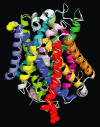System xc⁻ cystine/glutamate antiporter: an update on molecular pharmacology and roles within the CNS
- PMID: 21564084
- PMCID: PMC3252963
- DOI: 10.1111/j.1476-5381.2011.01480.x
System xc⁻ cystine/glutamate antiporter: an update on molecular pharmacology and roles within the CNS
Abstract
System x(c)(-) is an amino acid antiporter that typically mediates the exchange of extracellular l-cystine and intracellular L-glutamate across the cellular plasma membrane. Studied in a variety of cell types, the import of L-cystine through this transporter is critical to glutathione production and oxidative protection. The exchange-mediated export of L-glutamate takes on added significance within the CNS, as it represents a non-vesicular route of release through which this excitatory neurotransmitter can participate in either neuronal signalling or excitotoxic pathology. When both the import of L-cystine and the export of L-glutamate are taken into consideration, system x(c)(-) has now been linked to a wide range of CNS functions, including oxidative protection, the operation of the blood-brain barrier, neurotransmitter release, synaptic organization, viral pathology, drug addiction, chemosensitivity and chemoresistance, and brain tumour growth. The ability to selectively manipulate system x(c)(-), delineate its function, probe its structure and evaluate it as a therapeutic target is closely linked to understanding its pharmacology and the subsequent development of selective inhibitors and substrates. Towards that goal, this review will examine the current status of our understanding of system x(c)(-) pharmacology and the structure-activity relationships that have guided the development of an initial pharmacophore model, including the presence of lipophilic domains adjacent to the substrate binding site. A special emphasis is placed on the roles of system x(c)(-) within the CNS, as it is these actions that are among the most exciting as potential long-range therapeutic targets.
© 2011 The Authors. British Journal of Pharmacology © 2011 The British Pharmacological Society.
Figures







References
-
- Allalunis-Turner MJ, Day RS, 3rd, McKean JD, Petruk KC, Allen PB, Aronyk KE, et al. Glutathione levels and chemosensitizing effects of buthionine sulfoximine in human malignant glioma cells. J Neurooncol. 1991;11:157–164. - PubMed
-
- Allen JW, Shanker G, Aschner M. Methylmercury inhibits the in vitro uptake of the glutathione precursor, cystine, in astrocytes, but not in neurons. Brain Res. 2001;894:131–140. - PubMed
-
- Aoyama K, Suh SW, Hamby AM, Liu J, Chan WY, Chen Y, et al. Neuronal glutathione deficiency and age-dependent neurodegeneration in the EAAC1 deficient mouse. Nat Neurosci. 2006;9:119–126. - PubMed
Publication types
MeSH terms
Substances
Grants and funding
LinkOut - more resources
Full Text Sources
Other Literature Sources

